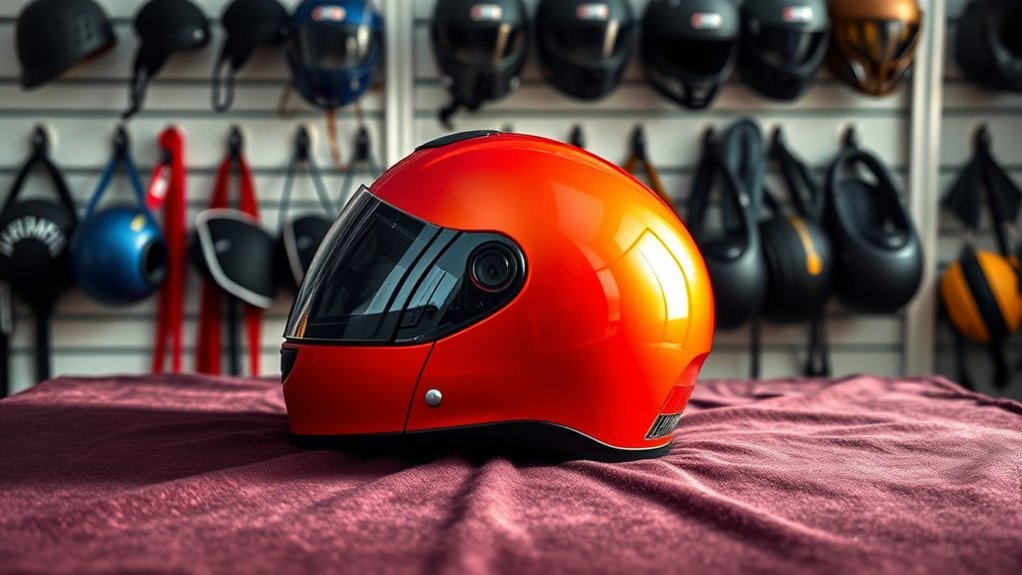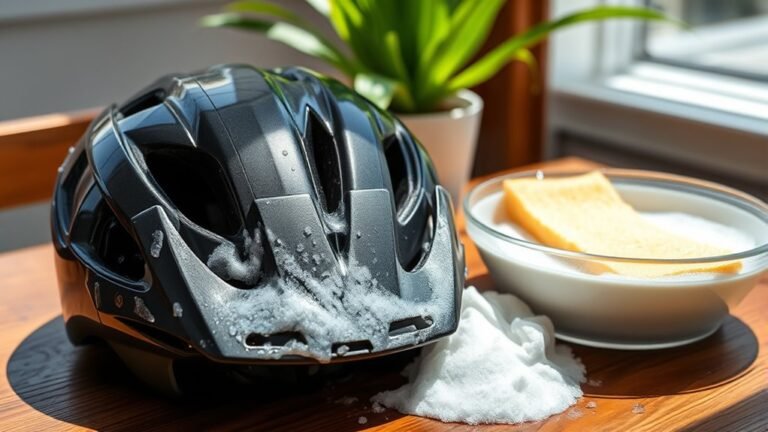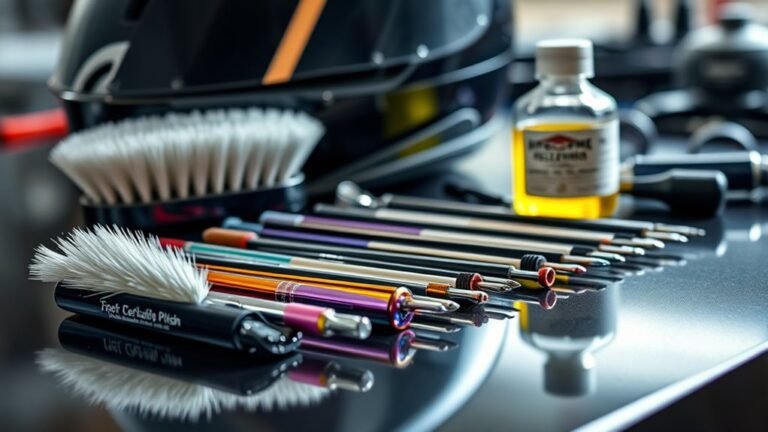Storing Your Helmet Properly to Prevent Damage
Storing your helmet properly is essential for maintaining its integrity and safety features. Keep it in a cool, dry place away from direct sunlight to prevent warping and degradation. Use a dedicated helmet bag or shelf for protection and avoid placing heavy items on top. Regularly clean your helmet and check for signs of wear, such as cracks or frayed straps. Understanding these storage practices can enhance your helmet’s lifespan and performance, ensuring reliable protection on your adventures.
Understanding the Importance of Helmet Storage
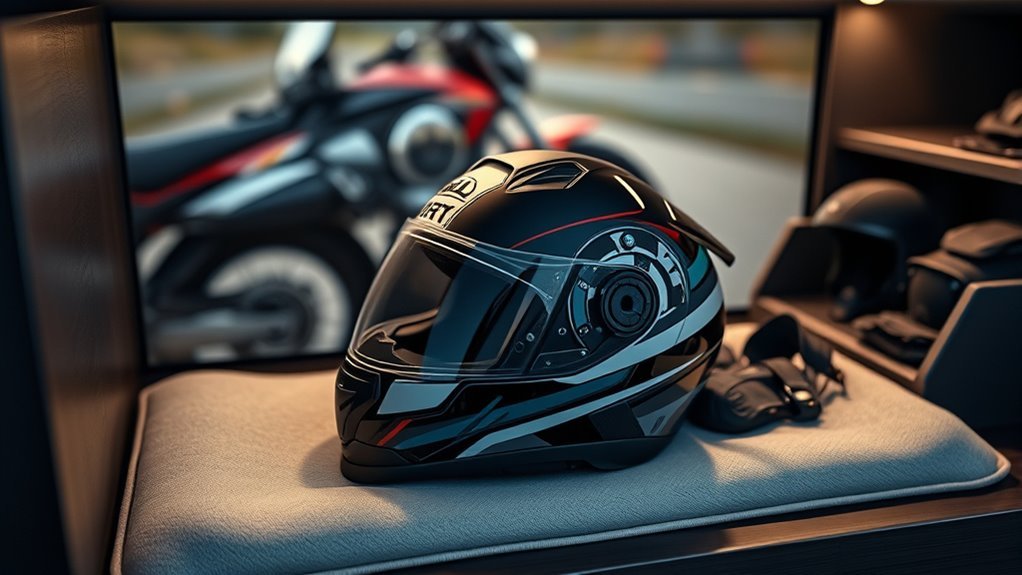
While it may seem trivial, proper helmet storage is crucial for maintaining its integrity and safety features. Your helmet’s lifespan can drastically decrease if you make common storage mistakes. For instance, leaving it in direct sunlight or extreme temperatures can weaken the materials, compromising its protective capabilities. Similarly, tossing your helmet into a bag without care can lead to scratches or structural damage. Instead, consider a dedicated space where it’s not exposed to harsh conditions. Using a helmet bag or a designated shelf prevents unnecessary wear and tear. By prioritizing how you store your helmet, you guarantee it remains a reliable companion on all your adventures, ultimately safeguarding your freedom and well-being on the road or trail.
Ideal Storage Conditions for Your Helmet
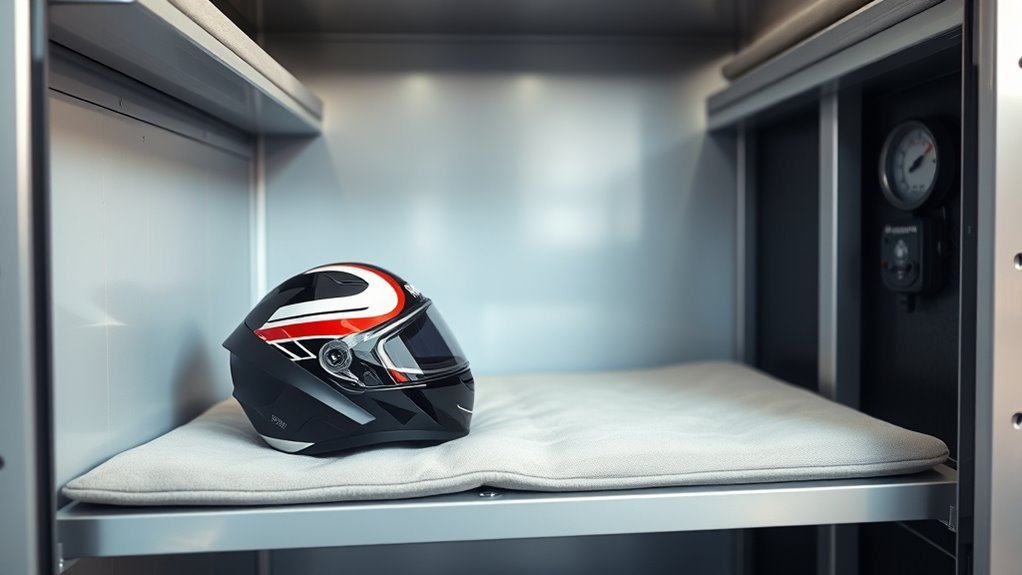
To guarantee your helmet remains in ideal condition, it’s essential to store it in a controlled environment. Different helmet types, whether for biking, skiing, or motorcycling, require specific care. Keep your helmet in a cool, dry place, away from direct sunlight and extreme temperatures, which can degrade the materials. Ideal humidity levels should be maintained to prevent mold or mildew. Utilize appropriate storage solutions, like a helmet bag or a dedicated shelf, to protect it from bumps or falls. Avoid placing heavy items on top of your helmet, as this can cause deformation. By ensuring these conditions, you’ll preserve your helmet’s integrity and enhance your freedom to enjoy your rides safely.
Choosing the Right Storage Location

When it comes to storing your helmet, choosing the right location is essential for maintaining its integrity. Indoor storage is generally preferable, as it allows you to better control temperature and humidity, reducing the risk of damage. Avoid placing your helmet in direct sunlight or damp areas, as these conditions can compromise its materials over time.
Indoor vs. Outdoor Storage
Choosing the right storage location for your helmet can greatly impact its longevity and performance. When deciding between indoor and outdoor storage, consider the following factors:
- Protection from elements: Indoor storage shields your helmet from rain, sun, and dust.
- Temperature stability: Indoor spaces maintain a consistent temperature, reducing risk of warping.
- Accessibility: Indoor storage keeps your helmet ready for use whenever adventure calls.
- Security: Indoor locations offer better protection against theft compared to outdoor setups.
While outdoor storage might seem convenient, it often exposes your helmet to harsh conditions that can compromise its integrity. Opt for indoor storage whenever possible to guarantee your helmet stays in peak condition, ready to provide the protection you need on your rides.
Temperature and Humidity Control
Indoor storage not only protects your helmet from external elements but also plays a significant role in maintaining perfect temperature and humidity levels. Choose a location away from direct sunlight and extreme temperature fluctuations, like attics or garages, which can compromise your helmet’s integrity. Instead, opt for a cool, dry space where humidity levels remain stable. A closet or a dedicated storage area can work well. If you live in a particularly humid environment, consider using a dehumidifier to mitigate moisture. Remember, prolonged exposure to high humidity can lead to mold growth or material degradation. By controlling these factors, you’ll guarantee your helmet stays in prime condition, ready for your next adventure.
Proper Cleaning Before Storage
Before storing your helmet, it’s essential to remove any dirt and debris that may have accumulated during use. Use a mild detergent and a soft cloth to gently clean the exterior, ensuring you don’t damage the helmet’s surface. This simple cleaning step helps maintain your helmet’s integrity and prolongs its lifespan.
Remove Dirt and Debris
Cleaning your helmet is essential for ensuring its longevity and performance. Before storing, effective debris removal is vital. Use these cleaning techniques to keep your helmet in top shape:
- Gently wipe the outer shell with a soft cloth to remove dust.
- Use a small brush to dislodge dirt from vents and crevices.
- Rinse the visor with water to eliminate smudges and grime.
- Check the interior padding for any loose debris and vacuum if necessary.
Use Mild Detergent
While it might be tempting to skip this step, using a mild detergent is crucial for maintaining your helmet’s integrity before storage. Mild detergent benefits include effectively removing oils, sweat, and grime without damaging the helmet’s materials. Start by mixing a small amount of mild detergent with warm water, then use a soft cloth or sponge to gently clean the exterior and interior surfaces. Be sure to follow helmet cleaning techniques, focusing on areas that accumulate dirt. Rinse thoroughly with clean water to guarantee no detergent residue remains, as this can degrade the materials over time. Once clean, dry your helmet completely before storage to prevent mold and mildew. This simple step helps extend your helmet’s lifespan and guarantees it’s ready for your next adventure.
Using Helmet Bags and Cases
Many riders overlook the importance of using helmet bags and cases for proper storage. These protective cases not only shield your helmet from dust and scratches but also extend its lifespan. When you invest in a quality helmet, you should also invest in a good bag. Here are some helmet bag benefits you shouldn’t ignore:Many riders underestimate helmet bags, which safeguard helmets from dust and damage while enhancing longevity. Invest in a quality bag!
- Protection: Keeps your helmet safe from impacts and abrasions.
- Convenience: Easy transportation for your gear during rides.
- Organization: Helps keep your helmet separate from other equipment.
- Style: Many bags come in various designs, reflecting your personality.
Avoiding Extreme Temperatures
Since helmets are made from materials sensitive to temperature fluctuations, it’s crucial to store them away from extreme heat or cold. Extreme heat can warp the inner foam and damage the outer shell, while extreme cold may make the materials brittle, increasing the risk of cracks. Ideally, you should keep your helmet in a climate-controlled area, such as a closet or storage room, rather than in a garage or vehicle exposed to the elements. If you ride frequently, consider investing in a dedicated storage solution that shields your helmet from temperature extremes. By taking these precautions, you’ll help maintain your helmet’s integrity and guarantee it performs effectively when you need it most, allowing you to ride freely without worry.
Protecting From Moisture and Humidity
To guarantee your helmet remains in prime condition, it’s essential to protect it from moisture and humidity. Excess moisture can lead to mold, mildew, and unwanted odors, while humidity control is vital for maintaining the integrity of the materials. Here are some tips to help you:
- Store your helmet in a cool, dry place.
- Use moisture-absorbing packets or silica gel to reduce moisture absorption.
- Avoid leaving it in damp areas, like garages or basements.
- Regularly inspect your helmet for signs of moisture damage.
Keeping Away From Direct Sunlight
While it might be tempting to leave your helmet in a sunny spot for easy access, direct sunlight can greatly degrade its materials over time. Prolonged sunlight exposure leads to UV damage, weakening the structural integrity and reducing the helmet’s effectiveness during rides. To preserve your helmet’s lifespan, store it in a cool, shaded area, away from windows and direct light. Consider using a helmet bag or a dedicated storage container to shield it from harmful rays. Remember, your helmet is an essential piece of gear that protects your freedom on the road, so treat it with care. By keeping it out of the sun, you’re ensuring it stays safe and reliable for all your adventures ahead.
Regular Inspections and Maintenance
Regular inspections and maintenance are essential for guaranteeing your helmet remains in top condition. Performing routine checks not only enhances safety but also prolongs its lifespan. Here are some maintenance tips to follow:
- Inspect the outer shell for cracks or dents after each use.
- Check the interior padding for signs of wear or compression.
- Examine the straps and buckles to guarantee they’re secure and functional.
- Clean your helmet regularly with mild soap and water to remove dirt and sweat.
When to Replace Your Helmet
You should regularly check your helmet for signs of wear, such as frayed straps or cracks in the shell. If your helmet has sustained any impact, even if there are no visible damages, it’s best to replace it. Trust your instincts—if it feels compromised, it likely is.
Signs of Wear
As time passes, the effects of impact, UV exposure, and general wear can compromise your helmet’s integrity, making it essential to recognize when it’s time for a replacement. Knowing the helmet lifespan is vital for ensuring your safety. Look out for these wear indicators:
- Cracks or dents: Any visible damage can drastically reduce protection.
- Faded colors: This can signal UV degradation, affecting material strength.
- Worn straps: If they’re frayed or lose elasticity, it’s time for a new helmet.
- Poor fit: If it no longer sits snugly, it won’t provide adequate protection.
Stay vigilant about these signs, and don’t hesitate to replace your helmet when necessary. Your safety and freedom depend on it!
Impact and Damage
Even if a helmet appears intact after an impact, it may have sustained unseen damage that compromises its protective capabilities. It is crucial to perform a damage assessment after any significant fall or collision. Even minor impacts can affect the helmet’s integrity, so don’t ignore them. Consider the results of impact testing; many manufacturers recommend replacing your helmet every few years, even without visible signs of damage. If you notice cracks, dents, or if your helmet has been involved in a serious accident, it’s time to replace it immediately. Prioritizing your safety means being proactive about any potential damage. Your freedom on the road or trail depends on having the right protection—don’t take chances with an unreliable helmet.
Frequently Asked Questions
Can I Store My Helmet in a Closet?
Yes, you can store your helmet in a closet. Just make sure it’s in a safe spot where it won’t get crushed or knocked around. Consider using helmet storage options like a dedicated shelf or a hanging rack to keep it organized. Avoid placing heavy items on top, as that could damage it. Proper closet organization can help maintain your helmet’s shape and integrity, ensuring it’s ready for your next adventure.
Is It Safe to Hang My Helmet?
Yes, it’s safe to hang your helmet, but you should use proper hanging techniques. Avoid using hooks that might distort the shape or damage the padding. Instead, consider hanging it from a padded strap or a dedicated helmet holder. This way, you can maintain the helmet’s integrity and prolong its lifespan. Just make sure it’s in a cool, dry place, away from direct sunlight, to protect it from potential wear over time.
How Often Should I Check My Helmet Storage?
You should check your helmet storage at least once a month. Think of your helmet as a guardian of your freedom; keeping it in peak condition is essential. Follow helmet maintenance tips by ensuring it’s stored at a consistent temperature—ideally between 50°F and 70°F. Avoid extremes that could compromise its integrity. Regular checks help you catch any damage early, ensuring your adventures remain safe and worry-free. Your freedom depends on it!
Can I Store Multiple Helmets Together?
You shouldn’t store multiple helmets together, especially if you’re helmet stacking. This can lead to scratches and dents, affecting their safety and performance. Instead, prioritize helmet organization by keeping each helmet in its own space. Use helmet bags or designated shelves to guarantee they don’t collide or get damaged. This way, you preserve their integrity and ensure you’re ready for any adventure without worrying about potential harm to your gear.
What Should I Do if My Helmet Gets Wet?
If your helmet gets wet, don’t panic! Start by gently wiping off excess water with a soft cloth. For effective helmet drying techniques, place it in a well-ventilated area, avoiding direct sunlight or heat sources. You can also stuff it with newspaper to absorb moisture. This helps prevent moisture damage and keeps your helmet in top shape. Regularly check for any lingering dampness to guarantee it stays safe for your next adventure!
